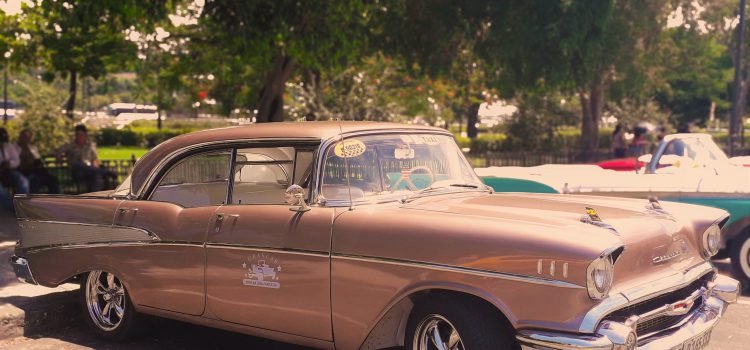The 1957 Chevrolet, unlike any other American car and contrary to industrial practice at the time, was manufactured for 10 years.
It is a car introduced by Chevrolet in September 1956 for the 1957 model year.
Subsequent models have been made for the Chevrolet of the following years, but the 57, has always been a very popular and requested classic car.
They are often restored to their original state and sometimes modified, but they remain an automatic icon.
Do not hesitate, come to Cuba.
Here you can enjoy these walking wonders, which despite the years continue to travel through the Cuban streets.
Aspects to be treated:
- What were the versions available for the year 1956?
- History of the Chevrolet ’57.
- Popularity of the Chevrolet ’57.
- What type of engine used the Chevrolet ’57?
- What were the Gearbox alternatives in a Chevrolet ’57?
- Curiosity.
What were the versions available for the year 1956?

Chevrolet, due to the appearance of new car brands, found itself in a real challenge: to ensure that the 1957 had the public’s favor coming from two very good years with the 1955 and 1956 models that had established very high parameters in terms of Quality, design and technology.
By September 11, 1956, three models of the series were available:
- the basic one, called “Chevrolet 150”,
- the intermediate, called “Chevrolet 210” and
- the star version: Chevrolet BelAir that corresponded to the luxury models
- The basic version: 150
These were models with minimal ornaments.
Bodyworks:
4-door sedan with two doors, utility sedan and a two-door Wagon Handyman station with or without rear windows.
The latter to be used in the transport of light merchandise. Those that could be called delivery.
The side moldings version 150, included very small side sockets, also tire rates that barely covered the center of the tires.
-
The average version: 210
With greater exterior ornamentation and chrome.
Bodyworks:
Coupe with two doors, with and without central stops, four doors with or without central stops, the same as station wagon with two and four doors and the possibility of having in the latter with seats for six or nine passengers.
This version, had larger sockets, but not reaching those proposed for the Belair series. Also minimum size tire rates.
-
The Bel Air version
Definitely the most luxurious version.
Bodyworks:
Two-door coupé with or without central stops, four-door sedan with or without stops, a beautiful convertible coupe and the four-door Station Wagon, plus a luxury two-door station called Nomad.
In the Belair series, in addition to the sockets that were used in the 210, two imposing aluminum strips of almost triangular shape were included for the sides of the car.
As well as chrome moldings for the tail fins and tire rates that completely covered it, for which outstanding ornaments were acquired to be mounted in the center of these.
History of the Chevrolet ’57:
 Initially, General Motors executives wanted a completely new car by 1957, but production delays made the 1955-1956 design necessary for another year.
Initially, General Motors executives wanted a completely new car by 1957, but production delays made the 1955-1956 design necessary for another year.
Ed Cole, chief engineer of Chevrolet, dictated a series of changes that significantly increased the cost of the car.
These changes helped make the Chevrolet ’57 a classic.
They include a new instrument panel, the closed hood, and the relocation of the air ducts of the headlight pods.
The fifteen-inch wheels from previous years were replaced by fourteen-inch wheels, with the purpose of giving the car a lower posture.
Another change was the use of a wide fence to give the car a wider appearance of the front.
The now famous ’57 Chevrolet in the queue were designed to double the wide look in the rear.
The base engine was a 6-cylinder in-line called the Blue Flame Six. The engine was running smoother than the V8.
The carburetor came from a single barrel carburetor.
Chevrolet ’57 Popularity:

From a numerical point of view, the Chevrolet ’57 was not as popular as General Motors had expected.
Despite its popularity, rival Ford Motor Company sold more than Chevrolet for the 1957 model year, for the first time since 1935.
The main cause of the displacement of Ford sales was the fact that the ’57 Chevrolet had tubeless tires, the first car with this.
This scared them away from Chevrolet sales to those of Ford because many people do not trust the new design without an air chamber. Ford introduced a new body design that was long, shorter and wider than last year’s offer that helped Ford sales.
However, the 1957 Ford is not as appreciated by collectors today as the 1957 Chevrolet.
Throughout the 1960s and 1970s, the Chevrolet ’57 was a popular used car and much appreciated “street machine” or race car in 1957.
The ideal size of ’57, combined with its relatively light weight compared to the most recent full-size cars, made it a favorite among drag racers.
The engine compartment was large enough to fit in GM’s large block engines, for the first time in 1958 and popularized in the 1960s by The Beach Boys in the song “409.”
.
What type of engine used the Chevrolet ’57?
 There were three options, a basic six-cylinder in-line, of 3,849cc called Blue Flame Six that was already available for De Luxe models.
There were three options, a basic six-cylinder in-line, of 3,849cc called Blue Flame Six that was already available for De Luxe models.
The 1957 model offered a power of 140 HP. 5-bed engine with a Rochester carburetor.
The big news: the renowned and famous V8 engine of 4,340cc and small block used for the first time in 1955 and 1956 that produced 162 or 170 HP, respectively.
And finally a new V8 with greater displacement, could give a power of 185, 220, 245, 250, 270 and 283 horses, depending on whether one or more carburetors and various mechanical adjustments were incorporated.
The new engine at peak performance achieved the amazing power of a horse for every cubic inch of travel.
For the first time in Chevrolet’s history, they presented a mechanical fuel injection system called “Ramjet” made of aluminum, and that was constituted in a whole technological innovation and even more so in a low-priced vehicle, as was the case of Chevrolet.
What were the Gearbox alternatives in a Chevrolet ’57?

Chevrolet offered several gearbox alternatives: a three-speed manual gearbox, operated from the steering column, (steering wheel lever) which it could have, or not.
In addition the well-known two-speed Powerglide automatic transmission forward (available on Chevrolet models since 1950) paying $ 188 more.
And the new three-speed automatic Turboglide adding to the price of the vehicle 230 dollars.
There were also many options available, to make the car more comfortable and luxurious.
Between them:
- In 1957, Chevrolet began adding safety features such as “crash-proof locks” (first added in 1956), padded dashboards, and safety-style steering wheel with a recessed center.
- 1957 was also Chevrolet’s first offer of a turbine transmission, known as the Turboglide.
- One element of the mounted panel was the traffic light spectator, a corrugated plastic visor that was installed just above the speedometer.
Because the roof extends in front of the driver, it is difficult to see general traffic lights.
The traffic light viewer captures the reflection of the traffic lights above so that the driver does not have to lean forward to see beyond the edge of the roof.
Curiosity:
The Chevrolet ’57 won the 49 Grand National “cup” NASCAR races (more than any other car in NASCAR history).
He also won the Southern 500 (in 1957, 1958 and 1959); becoming the only car to win the 500 three times.
The first victory of a Chevrolet ’57 in a Formula One Grand National Series race was 1957 Virginia 500.
The ’57 also won 26 NASCAR “convertible” races, more than any brand, and won all three possible driving championships.
The first in convertible class in the 1959 Daytona 500 was a ’57 driven by Joe Lee Johnson.

